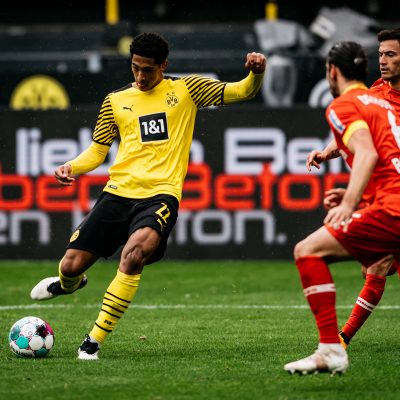In October 2018, the Americas office of the DFL subsidiary Bundesliga International opened in New York City. Twelve months later, Arne Rees, Executive Vice President Strategy, and Melanie Fitzgerald, Head of Americas, draw conclusions of their first year in the Big Apple, provide insights into their work and talk about the wide range of opportunities for the Bundesliga on the American continent.
Arne Rees, Melanie Fitzgerald, how do you sum up the first year of the Regional Head Office Americas in New York?
Melanie Fitzgerald: The first year of the Americas office was largely about launching a physical presence within the region, hiring a team with local expertise and better understanding our target fanbases to ensure we connect with fans, support our partners and leverage in-market club activities.
Arne Rees: One of the key objectives we set for ourselves in the first year was to put together a great team and to find a long-term media partner who would value us both financially and as a brand partner. On both fronts we are very satisfied with the progress made. The team is excellent, and ESPN is the right long-term partner for the Bundesliga in the US.
The aim of the office is to further push the agenda of the Bundesliga across the Americas. What are the most important findings after one year?
Melanie Fitzgerald: We feel it’s especially important that when pushing the agenda of the Bundesliga across the Americas, we speak to our fans in their own tone and voice. As a result we find it essential that all marketing campaigns, initiatives and digital efforts are localized for the target markets within the region. Through our research we have identified our target audience to be what we have tagged ‘The Modern Soccer (Football) Fan’ being aged between 16 and 34 with a specific focus on the younger age group, the 16 to 24-year olds, within the segment. We know these fans to be especially digital savvy, with a consumption behavior heavily defined by digital streaming and social media platforms. We must find more ways to make the Bundesliga accessible to these fans and ultimately become part of the daily soccer conversation within each market.
Arne Rees: Telling our story must be pitch perfect. At the moment the Bundesliga in the US stands for the highest quality, which is a great starting point. Our work will be to further bring the fan driven culture of the Bundesliga to US fans.
Were there events or developments you undertook or supported that deserve a special mention?
Melanie Fitzgerald: We’ve organized a number of successful events across the continent, but one that stands out for me is the Bundesliga Experience which took place in Mexico City last April. There we hosted one of the largest watch parties to-date for “Der Klassiker”, with over 1,500 fans in attendance for the game and more than 5,000 joining us over the two days of activities. We are looking to build on this in Rio de Janeiro, Brazil this coming November and again in Mexico City in April 2020. In efforts to specifically target the ‘Modern Soccer Fan’ noted above, we recently launched a Facebook Group for US Bundesliga fans which provides a dedicated space for more in-depth and meaningful conversations among our fans online. The platform functions as an information hub where broadcast partners as well as Bundesliga clubs can also actively participate and inform through their respective Facebook groups. Lastly, we couldn’t be more pleased with the recent long-term partnership announced with ESPN, which kicks-off in the 2020-21 season. Innovation is also a hot topic in the region, particularly in the US, which means that we really have to capitalize on the Bundesliga being football’s innovation leader. I’m confident that over the coming months we will have some more exciting developments in this area, whilst we are also looking forward to hosting our first Future Innovation Summit in New York on 29 October. This gives us the perfect opportunity to showcase the DFL’s success in this area to a selected audience in what will be a taster for the headline event, SportsInnovation 2020, which will be held by Messe Düsseldorf and the DFL in Düsseldorf in March 2020.
How do you experience the popularity of the Bundesliga in the US?
Arne Rees: Part of opening the US office was to increase the profile of the Bundesliga within the Americas. It is not only about the US and Canada, but we also want to get closer to Mexico, Brazil and Latin America as a whole. Football has a very strong culture, but it is not uniform. Each football fan represents a local culture, therefore as the DFL we have to understand how we are perceived and work market by market in order to be more connected to each of the various nuances. In the case of the US, football has experienced large growth in recent years. Using our Fan Extended Research, we have found that the USA has over 60 million soccer fans, so there’s a lot of potential for further growth. At this point, football is the most popular sport for seven per cent of people in the US – compared to just two per cent in 2000. This is, among other things, due to the 2026 FIFA World Cup being hosted by USA, Canada and Mexico, the growing popularity of the EA SPORTS FIFA video game and eFootball in general, US National Team players like Weston McKennie from FC Schalke 04, Josh Sargent from SV Werder Bremen and Tyler Adams from RB Leipzig, the growth of youth participation, and the growth of Major League Soccer. The Bundesliga in the USA is seen as a hotbed for American players, standing for quality. Our job will be to tell the story and further strengthen the connection between the US and Germany.
Another goal is to support the clubs in their internationalization activities. How does this work?
Melanie Fitzgerald: Yes, supporting the clubs in their internationalization activities is indeed a priority for our office. Over the last twelve months we have supported clubs with not only their US tours but also watch parties across the country, producing localized content in partnership with our broadcast partners and also providing club executives and their US agencies with a physical office space in New York.
Can you name any hard facts or figures which stand for the Bundesliga in the Americas?
Melanie Fitzgerald: Last November, the league worked with academics to produce a Harvard Business Review case study. This provided interesting insights into how the US consumes sports, soccer and more specifically Bundesliga. What we found was that in the US there were over 9,000 hours of live football being broadcast from more than 20 networks in 2015. In addition, most networks showed their football competitions not only on TV but also online via live streaming. Some games were even streamed online exclusively. Prior to the deal with Fox in 2015, the Bundesliga was only available to only 13 million households, but through the new partnership the Bundesliga became accessible to 85 million households. Interestingly, there is a strong willingness of consumers to pay for multiple subscriptions, which could become even more meaningful with the current trend of transition from traditional broadcast or cable pay-tv to OTT. What the report found was that the US sports consumers preferred to commit to an annual subscription fee followed by per game/event payments, monthly subscriptions and per sports subscriptions. More importantly, it reinforced the belief that leveraging familiar touch points between US and Germany will in fact create interest and ultimately fandom in the Bundesliga. We have an advantage in the US market that we’ve had over 50 US players playing in the Bundesliga since it’s foundation. In recent years, the Bundesliga continues to be a hotbed for American players and a breeding ground for the US Men’s National Team. Another strong touchpoint is Jürgen Klinsmann, former coach of the US national team from 2011 to 2016. Building further connections between our fans and partners across the Americas will continue to be a priority for us.




